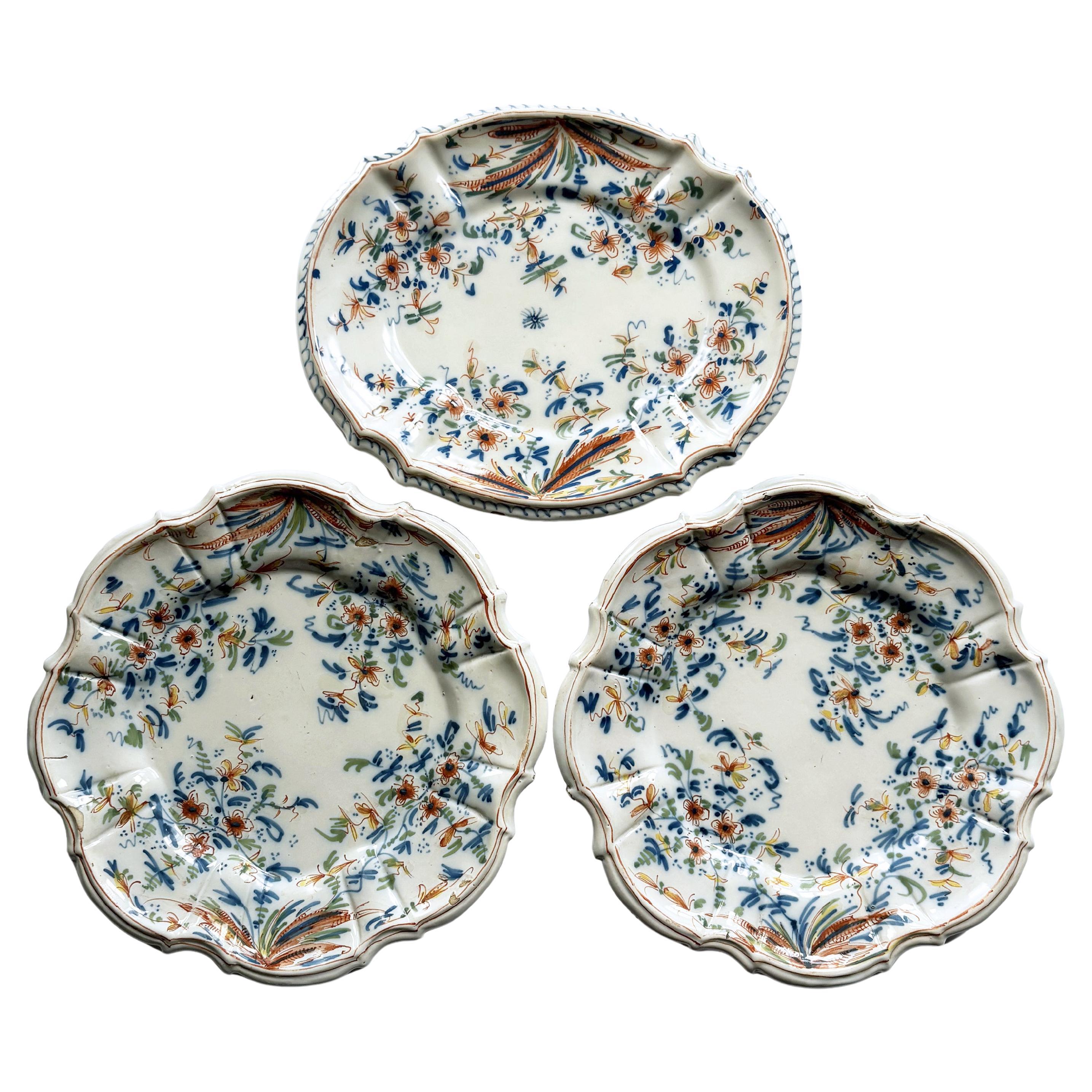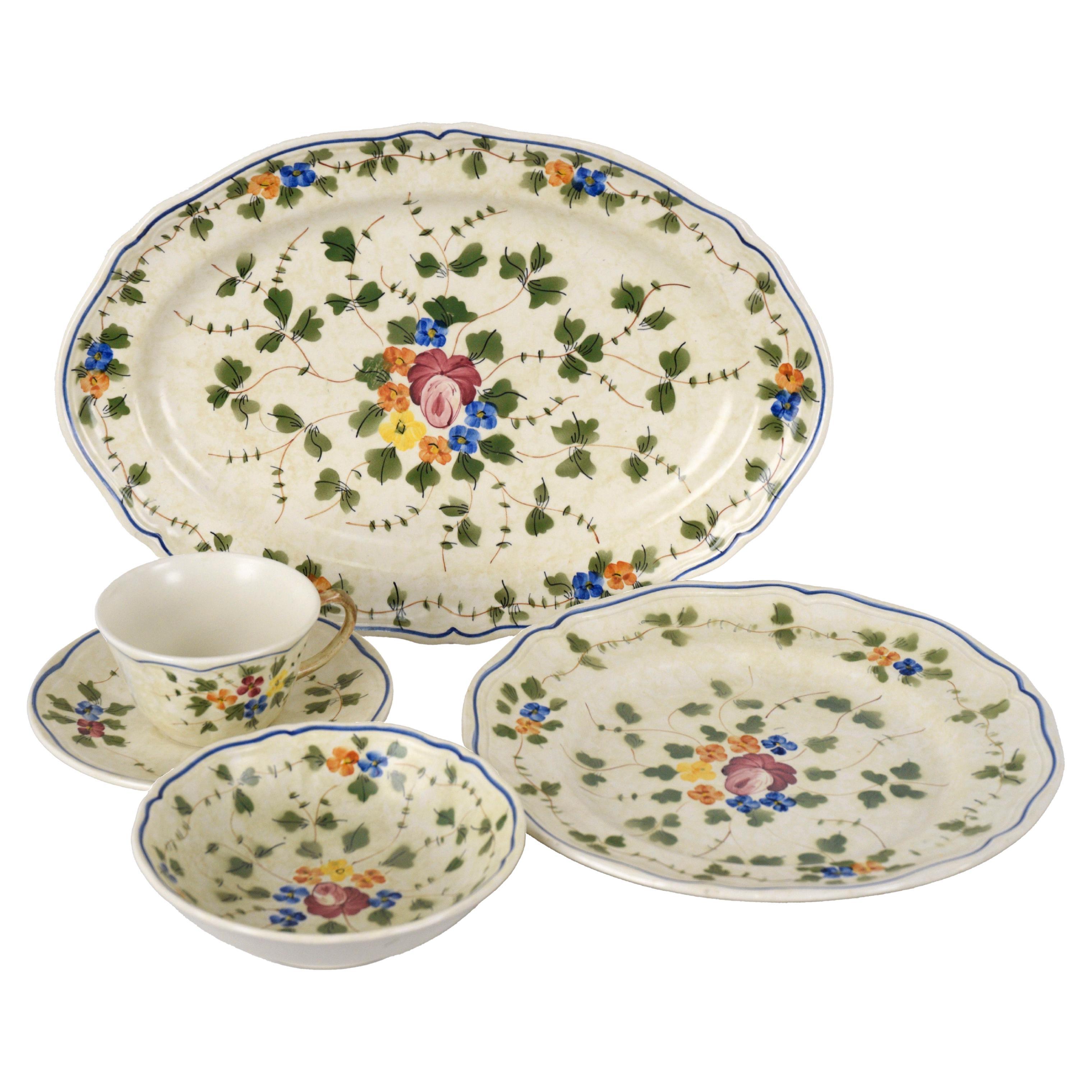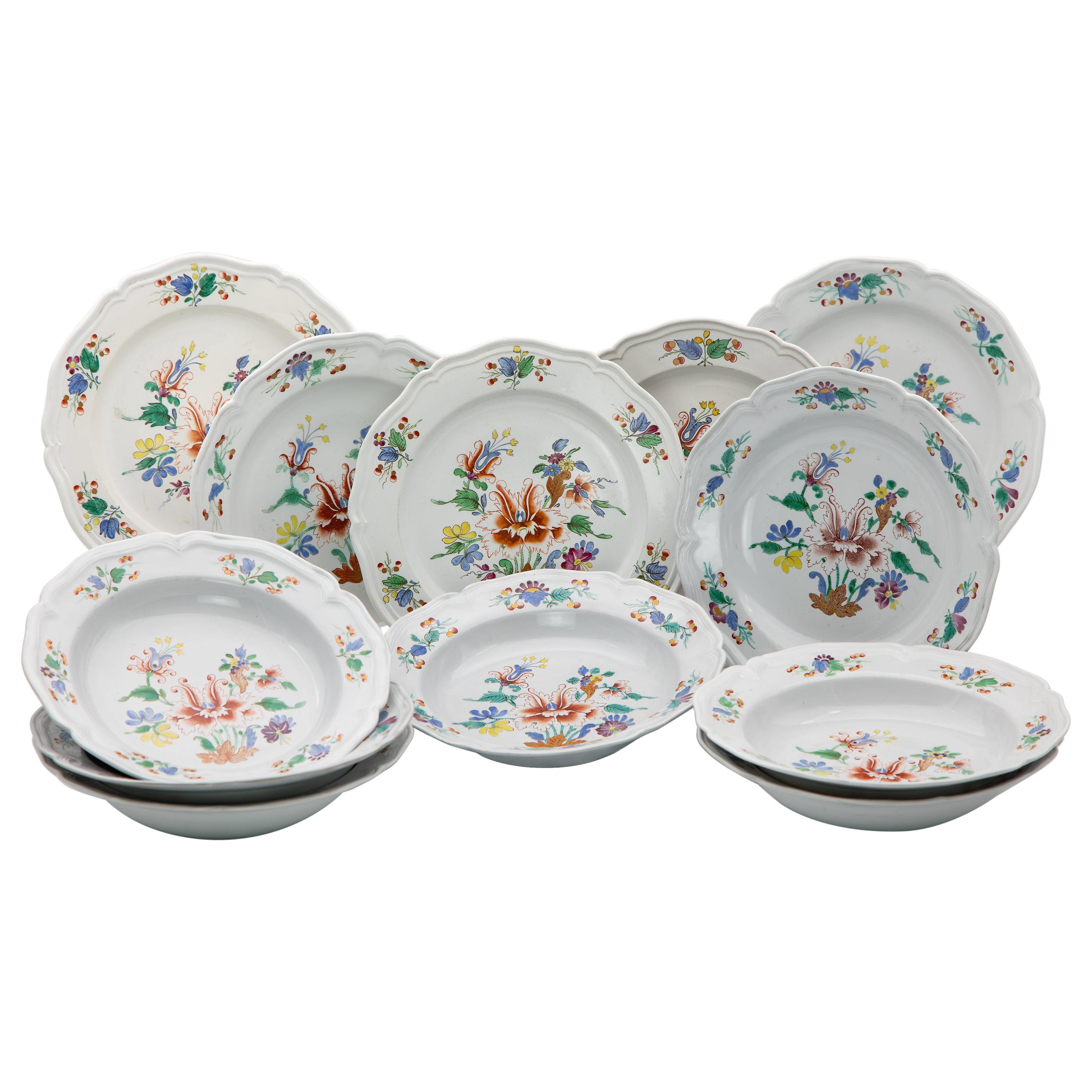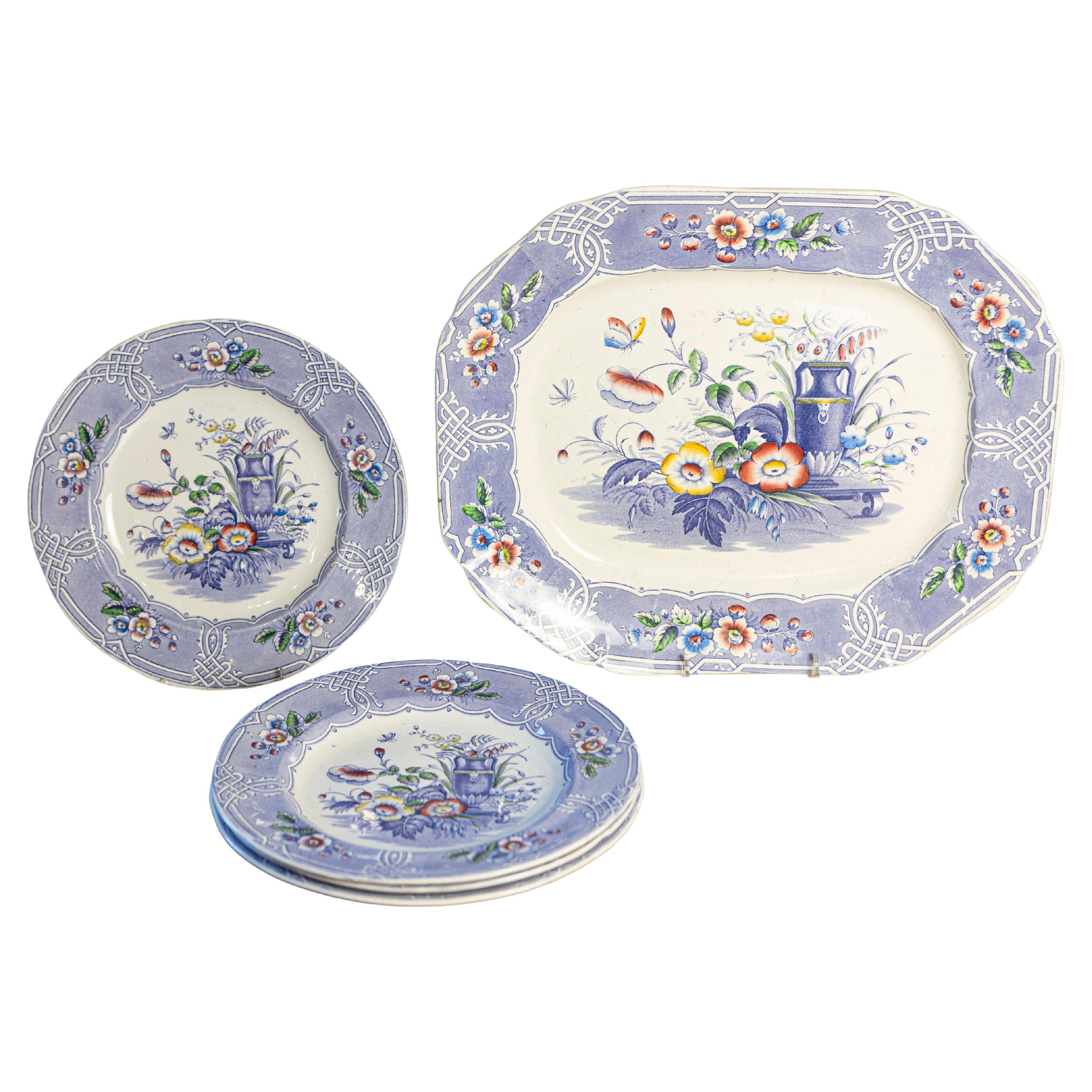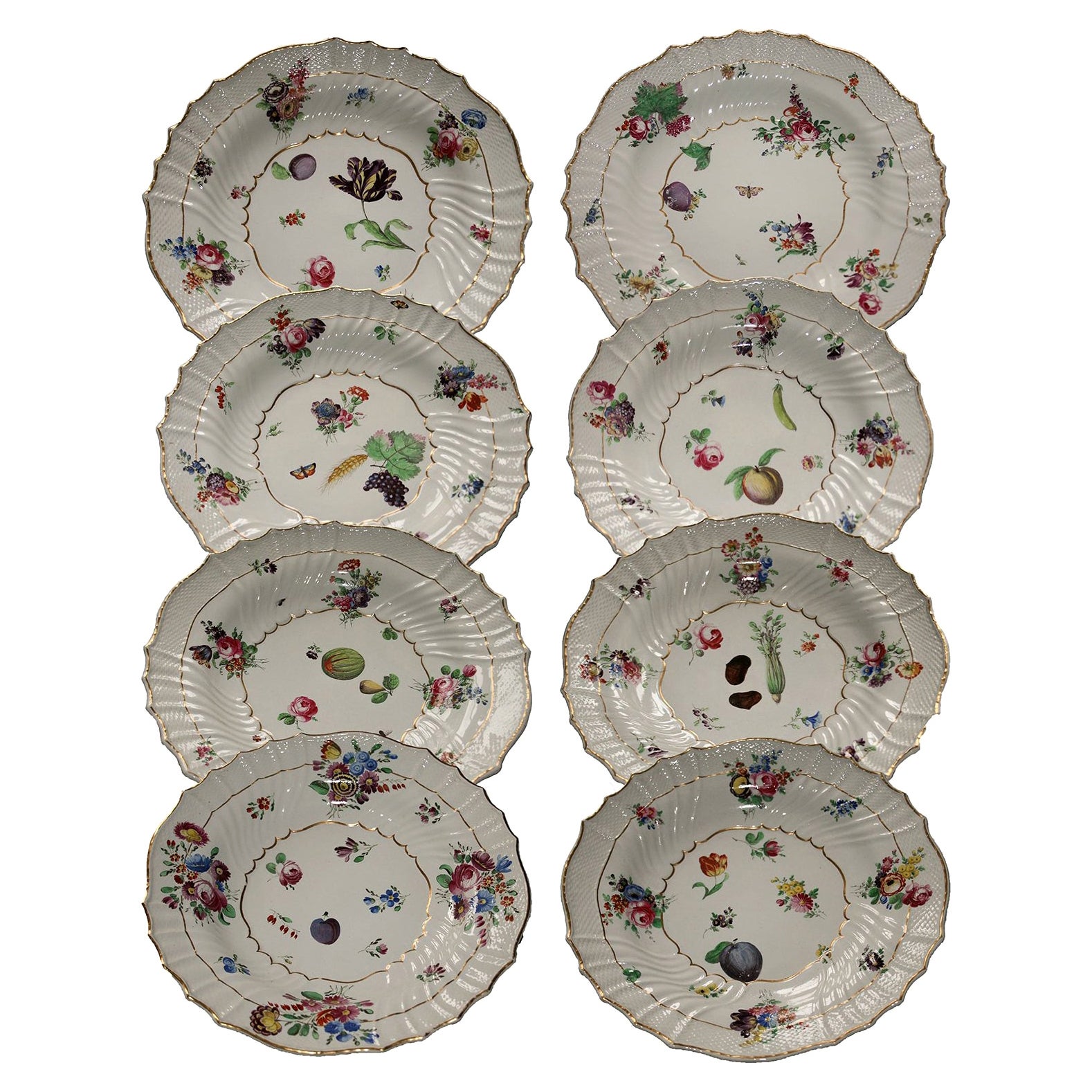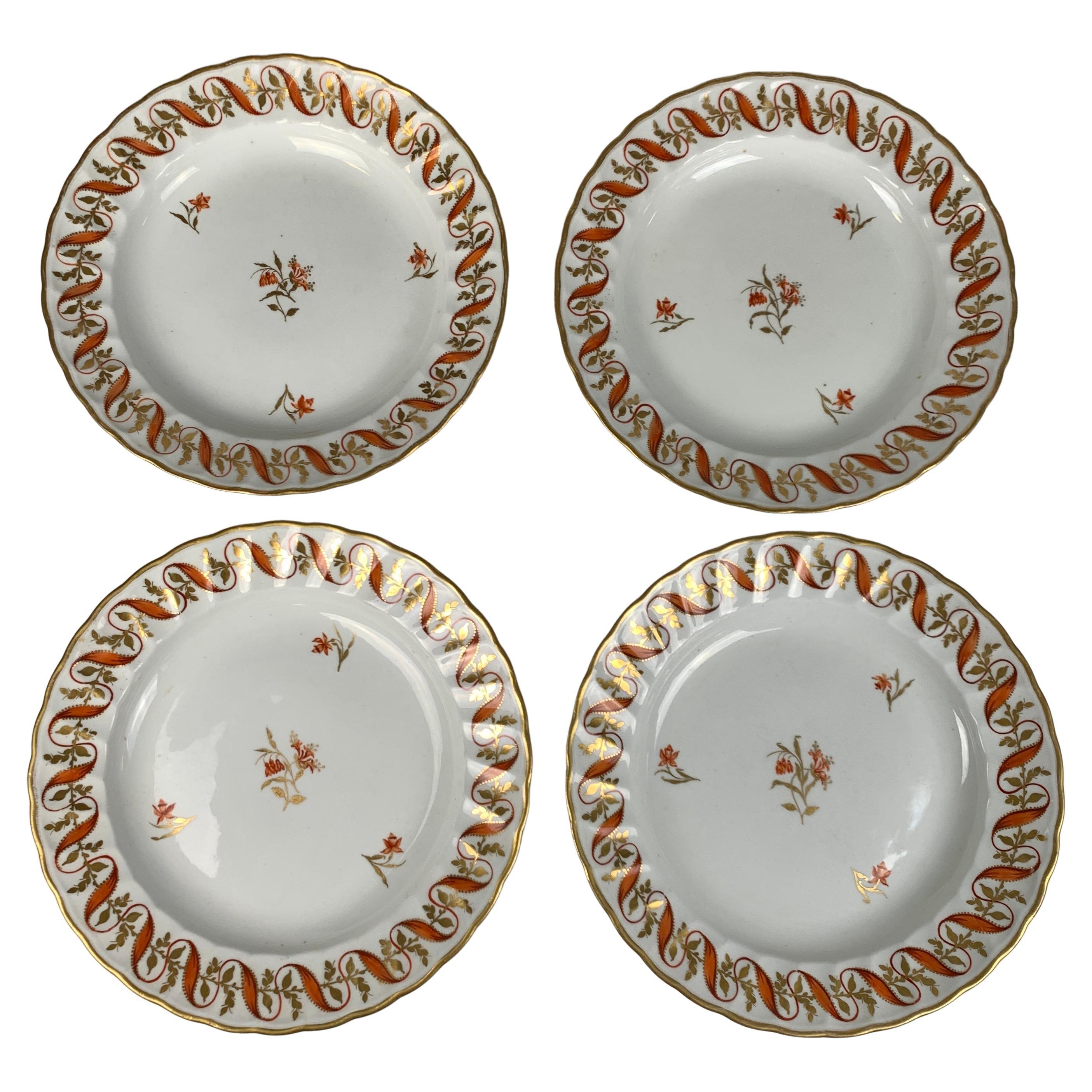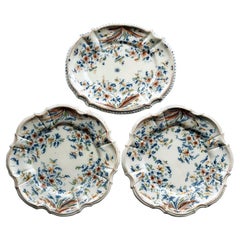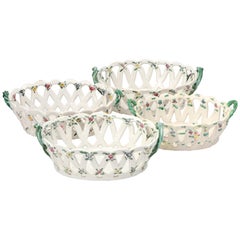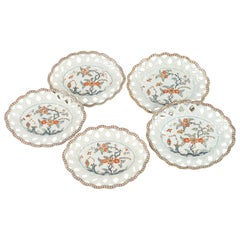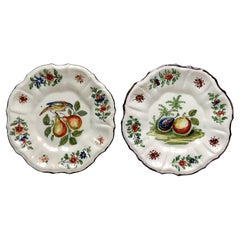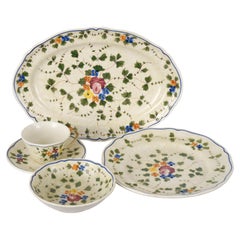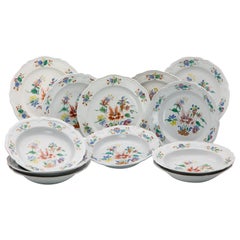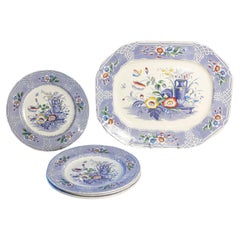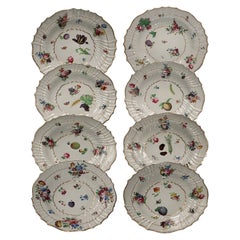Items Similar to Four Italian Ancient Dishes, Antonio Ferretti, Lodi, circa 1770-1780
Video Loading
Want more images or videos?
Request additional images or videos from the seller
1 of 20
Four Italian Ancient Dishes, Antonio Ferretti, Lodi, circa 1770-1780
$4,195.63per set
£3,116.76per set
€3,500per set
CA$5,826.11per set
A$6,357.64per set
CHF 3,334.69per set
MX$77,215.63per set
NOK 41,652.08per set
SEK 39,363.30per set
DKK 26,645.13per set
About the Item
Assortment of 4 dishes with braided rim
Antonio Ferretti Manufacture
Lodi, circa 1770-1780
Maiolica polychrome decorated “a piccolo fuoco” (third fire).
Measures: 14 x 10 in (35.5 x 25.5 cm);
12.2 x 8.39 in (31 x 21.3 cm);
10.4 x 9.65 in (26.5 x 24.5 cm);
10.8 x 9.61 in (27.5 x 24.4 cm).
Weight: 4.4 lb (1.998 kg)
State of conservation: some chips due to use on the edges and on the parts in relief.
The four different dishes have a foot with a low lip from which extends a wide, flat, slanted rim resembling a basket weave. The small handles are painted green: they resemble wickerwork in the two oval dishes and take the form of a sinuous branch in the round ones.
The third fire decoration is inspired by the naturalistic floral botanical patterns on the ceramics produced by the Hannong family in Strasbourg. Here the pattern is defined by the rapidity and subtlety of the brushstrokes and the result is particularly tasteful, characterized by compositional intelligence and pictorial expertise.
A main corolla, either a wild or garden rose, is set slightly off center in each well. From this extends a thin stem holding a small secondary bud and there are small field florets dotting the composition to lend volume to the delicate bunch of flowers.
On the brim, small polychrome flowers add color to the weave, accompanied by lanceolate leaves of a very intense green.
There exist few and very rare examples for comparison with this morphology: a round plate - entirely consistent with those in question - has been dated to around 1775 (S. Levy, Maioliche settecentesche lombarde e venete, Milano 1962, tav. 200). Two other dishes with a basket rim, but with parallel striped brim decoration, were exhibited in the 1995 exhibition on Lodi ceramics; the attribution to the Lombard town near Milan is therefore almost exclusively derived from the decoration called "alla rosa contornata" or "alla vecchia Lodi" and constitutes one of the most popular decorations during the eighteenth century. (M. L. Gelmini, in Maioliche lodigiane del '700 (cat. mostra Lodi), Milano 1995, pp. 31 p. 162-163 nn. 181-182).
This decorative choice represented a strong point of the Lodi factory, which established itself thanks to the vivid nature of the colors made possible by the introduction of a new technique perfected by Paul Hannong in Strasbourg and which Antonio Ferretti introduced in Italy. This production process, called “piccolo fuoco” (third fire), allowed the use of a greater number of colors than in the past; in particular, the purple of Cassius, a red made from gold chloride, was introduced. Its use allowed for many more tones and shades, from pink to purple.
The Ferretti family had started their Maiolica manufacturing business in Lodi in 1725.
The forefather Simpliciano had started the business by purchasing an ancient furnace in 1725 and, indeed, we have evidence of the full activity of the furnaces from April of the same year (Novasconi-Ferrari-Corvi, 1964, p. 26 n. 4). Simpliciano had started a production of excellence also thanks to the ownership of clay quarries in Stradella, not far from Pavia. The production was so successful that in 1726 a decree of the Turin Chamber came to prohibit the importation of foreign ceramics, especially from Lodi, to protect internal production (G. Lise, La ceramica a Lodi, Lodi 1981, p. 59).
In its initial stages, the manufacture produced maolicas painted with the “a gran fuoco” (double fire) technique, often in turquoise monochrome, with ornamentation derived from compositional modules in vogue in Rouen in France. This was also thanks to the collaboration of painters like Giorgio Giacinto Rossetti, who placed his name on the best specimens next to the initials of the factory.
In 1748 Simpliciano made his will (Gelmini, 1995, p. 30) appointing his son Giuseppe Antonio (known as Antonio) as universal heir. After 1750, when Simpliciano passed away, Antonio was directly involved in the Maiolica factory, increasing its fortunes and achieving a reputation on a European level. Particularly important was the aforementioned introduction in 1760 of the innovative “a piccolo fuoco” (third fire) processing, which, expanding the ornamental repertoire with Saxon-inspired floral themes, could commercially compete with the German porcelains that had one of its most renowned offerings in the naturalistic Deutsche Blumen. Antonio Ferretti understood and promoted this technique and this decoration, proposing it in a fresher and more corrective version, less linked to botanical tables, both with or without contour line, as well as in purple or green monochrome. After efforts to introduce more Industrial Production techniques to the sector succeeded, even the Ferretti manufacture, in the last decade of the eighteenth century, started heading towards decline despite its attempts to adapt production to neoclassical tastes.
In 1796 the Napoleonic battle for the conquest of the Lodi bridge over the Adda definitively compromised the furnaces. Production resumed, albeit in a rather stunted manner, until Antonio's death on 29 December 1810. (M. L. Gelmini, pp. 28-30, 38, 43 sgg., 130-136 (for Simpliciano); pp. 31 sgg., 45-47, 142-192 (for Antonio).
Bibliography
C. Baroni, Storia delle ceramiche nel Lodigiano, in Archivio storico per la città e i comuni del circondario e della diocesi di Lodi, XXXIV (1915), pp. 118, 124, 142; XXXV (1916), pp. 5-8;
C. Baroni, La Maiolica antica di Lodi, in Archivio storico lombardo, LVIII (1931), pp. 453-455;
L. Ciboldi, La Maiolica lodigiana, in Archivio storico lodigiano, LXXX (1953), pp. 25 sgg.;
S. Levy, Maioliche settecentesche lombarde e venete, Milano 1962, pp. 17 sgg.;
A. Novasconi - S. Ferrari - S. Corvi, La ceramica lodigiana, Lodi 1964, ad Indicem; Maioliche di Lodi, Milano e Pavia (catal.), Milano 1964, p. 17;
O. Ferrari - G. Scavizzi, Maioliche italiane del Seicento e del Settecento, Milano 1965, pp. 26 sgg.;
G. C. Sciolla, Lodi. Museo civico, Bologna 1977, pp. 69-85 passim;
G. Lise, La ceramica a Lodi, Lodi 1981;
M. Vitali, in Storia dell'arte ceramica, Bologna 1986, p. 251;
M. A. Zilocchi, in Settecento lombardo, Milano 1991, pp. 492-496;
M. L. Gelmini, in Maioliche lodigiane del '700 (cat. mostra Lodi), Milano 1995;
R. Ausenda (a cura di), Musei e Gallerie di Milano. Museo d’Arti Applicate. Le ceramiche. Tomo secondo, Milano 2000, pp. 213-220;
Felice Ferrari, La ceramica di Lodi, Lodi 2003.
- Creator:Antonio Ferretti (Manufacturer)
- Dimensions:Height: 1.38 in (3.5 cm)Width: 13.98 in (35.5 cm)Depth: 10.04 in (25.5 cm)
- Sold As:Set of 4
- Style:Neoclassical (Of the Period)
- Materials and Techniques:Maiolica,Glazed
- Place of Origin:
- Period:1770-1779
- Date of Manufacture:circa 1780
- Condition:Some chips due to use on the edges and on the parts in relief.
- Seller Location:Milano, IT
- Reference Number:1stDibs: LU4352221946072
About the Seller
4.3
Vetted Professional Seller
Every seller passes strict standards for authenticity and reliability
Established in 1860
1stDibs seller since 2018
21 sales on 1stDibs
Associations
International Confederation of Art and Antique Dealers' Associations
- ShippingRetrieving quote...Shipping from: Milano, Italy
- Return Policy
Authenticity Guarantee
In the unlikely event there’s an issue with an item’s authenticity, contact us within 1 year for a full refund. DetailsMoney-Back Guarantee
If your item is not as described, is damaged in transit, or does not arrive, contact us within 7 days for a full refund. Details24-Hour Cancellation
You have a 24-hour grace period in which to reconsider your purchase, with no questions asked.Vetted Professional Sellers
Our world-class sellers must adhere to strict standards for service and quality, maintaining the integrity of our listings.Price-Match Guarantee
If you find that a seller listed the same item for a lower price elsewhere, we’ll match it.Trusted Global Delivery
Our best-in-class carrier network provides specialized shipping options worldwide, including custom delivery.More From This Seller
View AllThree Dishes, Antonio Maria Coppellotti Factory, Lodi, Italy, Circa 1745
By Antonio Maria Coppellotti
Located in Milano, IT
Pair of round dishes and a small oval tray
Antonio Maria Coppellotti factory
Lodi, circa 1745
High fire polychrome majolica
Dishes size: diameter 9.44 in, height 0.78 in (24 cm, 2 c...
Category
Antique 1740s Italian Rococo Delft and Faience
Materials
Maiolica
Two Pairs of Italian Maiolica Baskets, circa 1780
By Antonio Ferretti
Located in Milano, IT
Two pairs of maiolica baskets
Antonio Ferretti Manufacture
Lodi, circa 1770-1790
Maiolica polychrome decorated “a piccolo fuoco” (third fire).
Measures: A) Height 3.54 x 6.69 x 9.84 in (9 x 17 x 25 cm);
B) Height 3.93 x 7.48 x 11.02 in (10 x 19 x 28 cm).
Total weight 4.85 lb (2.200 kg)
State of conservation:
A) One of the smaller baskets has some areas of restoration, the other slight chipping from use;
B) One of the larger baskets is intact and the other shows a clearly glued break.
The mold with which the baskets were forged simulates a wicker weave.
The two larger works have high, vertical walls, with branch-shaped handles penetrating the weave. The painted decorations, small polychrome flowers applied only externally, highlight the points where the weaves intersect.
The decision to leave the center of the basket devoid of decoration is highly unusual, but given the size and complexity of the shape, as well as the quality of the enamel, it is possible to hypothesize that it represents a precise choice in manufacturing or for a particular client.
The two smaller baskets have small, twisted handles and, on the outside, reproduce more decisively the characteristic wicker weave, obtained through thin molded lines. The interior exhibits a rich, typical decoration of naturalistic flowers: a bunch centered around a main flower and secondary stems accompanied by small “semis”. The exterior of these works is also adorned with small little flowers where the weaves intersect.
The size and morphological characteristics of the baskets confirm their attribution to the Lodi factory of Antonio Ferretti between 1770 and 1790, during its most successful period; by this point his original reworking of the "Strasbourg" decoration, known as "old Lodi", had achieved great fame even outside Italy.
This decorative choice represented a strong point of the Lodi factory, which established itself thanks to the vivid nature of the colors made possible by the introduction of a new technique perfected by Paul Hannong in Strasbourg and which Antonio Ferretti introduced in Italy. This production process, called “piccolo fuoco” (third fire), allowed the use of a greater number of colors than in the past; in particular, the purple of Cassius, a red made from gold chloride, was introduced. Its use allowed for many more tones and shades, from pink to purple.
The Ferretti family had started their maiolica manufacturing business in Lodi in 1725.
The forefather Simpliciano had started the business by purchasing an ancient furnace in 1725 and, indeed, we have evidence of the full activity of the furnaces from April of the same year (Novasconi-Ferrari-Corvi, 1964, p. 26 n. 4). Simpliciano had started a production of excellence also thanks to the ownership of clay quarries in Stradella, not far from Pavia. The production was so successful that in 1726 a decree of the Turin Chamber came to prohibit the importation of foreign ceramics, especially from Lodi, to protect internal production (G. Lise, La ceramica a Lodi, Lodi 1981, p. 59).
In its initial stages, the manufacture produced maolicas painted with the “a gran fuoco” (double fire) technique, often in turquoise monochrome, with ornamentation derived from compositional modules in vogue in Rouen in France. This was also thanks to the collaboration of painters like Giorgio Giacinto Rossetti, who placed his name on the best specimens next to the initials of the factory.
In 1748 Simpliciano made his will (Gelmini, 1995, p. 30) appointing his son Giuseppe Antonio (known as Antonio) as universal heir. After 1750, when Simpliciano passed away, Antonio was directly involved in the maiolica factory, increasing its fortunes and achieving a reputation on a European level. Particularly important was the aforementioned introduction in 1760 of the innovative “a piccolo fuoco” (third fire) processing, which, expanding the ornamental repertoire with Saxon-inspired floral themes, could commercially compete with the German porcelains that had one of its most renowned offerings in the naturalistic Deutsche Blumen. Antonio Ferretti understood and promoted this technique and this decoration, proposing it in a fresher and more corrective version, less linked to botanical tables...
Category
Antique 1770s Italian Neoclassical Ceramics
Materials
Maiolica
Ancient Maiolica Plates Pasquale Rubati, Milan Circa 1770-1780
By Pasquale Rubati
Located in Milano, IT
Five oval maiolica dishes with pierced edge
Manufacture of Pasquale Rubati
Milan, 1770-1780
Three small oval dishes 10.23 in x 7.67 in (26 cm x 19.5 cm)
Two large oval dishes 10.82 in x 8.85 in (27.5 x 22.5 cm)
lb 3.5 (kg 1.8)
State of conservation: intact
The five dishes of different sizes have an oval shape, a mixtilinear edge and a molded polylobed shape with a surface enriched with a relief weave motif extending to the brim and forming a perforated basket...
Category
Antique 1770s Italian Rococo Ceramics
Materials
Maiolica
Two Small Italian Dishes Antonio Maria Coppellotti Manufacture, Lodi, Circa 1740
By Antonio Maria Coppellotti
Located in Milano, IT
Two small dishes
Antonio Maria Coppellotti Manufacture
Lodi, Circa 1740
High fire polychrome majolica
They measure: diameter 7.08 in(18 cm)
Weight: 0.37 lb (170 g)
State of conservat...
Category
Antique 1740s Italian Baroque Ceramics
Materials
Maiolica
Ancient Maiolica Dishes with flowers, Lombard Manufacture, 1770-1780 Circa
Located in Milano, IT
Assortment of dishes
Lombard manufacture
1770 – 1780 Circa
Maiolica polychrome decorated “a piccolo fuoco” (third fire).
Two large dishes: diameter 14.76 in (37.5 cm); weight 4.5...
Category
Antique 1770s Italian Rococo Ceramics
Materials
Maiolica
Italian Maiolica Cup Ferretti Lodi, circa 1770 - 1780
By Antonio Ferretti
Located in Milano, IT
Maiolica puerperal cup
Antonio Ferretti Manufacture
Lodi, Circa 1770 - 1780
Maiolica polychrome decorated “a piccolo fuoco” (third fire).
It measures: 4.3 x 6.8 x 5.3 in (11 x 17,5 x 13,5 cm)
Weight: 0.78 lb (358 g)
State of conservation: some closed pass-through fêlures on the cup, barely visible on the outside. Some use chips on the edge of the lid, two of which are more marked.
From about the mid-sixteenth century, the puerperal soup tureen or puerperal cup became one of the most popular wedding gifts in central Italy. As an auspicious symbol, it replaced the birth table (“desco da parto”) which, on the occasion of high-ranking marriages, from the thirteenth century, had been painted by famous artists, especially in Tuscany.
In France this same tureen is called "écuelle de mariée", as it is given to spouses as a sign of fertility.
During the eighteenth century this custom spread even outside Italy to all social levels. Depending on availability and rank, it was made of different materials: precious metals, maiolica, porcelain, glass, pewter, etc.
Beginning in the mid-twentieth century, the custom of this symbolic homage gradually disappeared, although famous designers such as Gio Ponti and Giuseppe Gariboldi, even as recently as the 1940s, revisited a model of a small puerperal soup bowl for the Ginori and, also in Italy in 1940, in a national competition for young potters, one of the themes of the test was indeed a modern model of a puerperal cup as an auspicious gift.
This particular cup was also called a "service cup" or "puerperal vase" or "stuffed cup" - the windows were sealed with straw to prevent drafts of air for women in labor.
In the eighteenth century the line of the puerpera cup was simplified, so much so that it took the form of a small tureen with two handles - the typical broth cup...
Category
Antique 1770s Italian Rococo Ceramics
Materials
Maiolica
You May Also Like
Vintage 4-Piece Longchamp Place Settings with Serving Tray, Set of 6, France
By Longchamps
Located in Soquel, CA
Vintage 4-Piece Longchamp Place Settings with Serving Tray, Set of 6, France
This beautifully hand-painted dish set is in good condition. The floral pattern features brightly colore...
Category
20th Century French French Provincial Tableware
Materials
Porcelain
18th Century Italian Doccia Porcelain Dinner Service
By Doccia Porcelain
Located in Fort Lauderdale, FL
A dinner service comprising six dinner dishes and six soup dishes made by the Doccia Porcelain Manufactory, circa 1750.
Italy was the site of Europ...
Category
Antique Mid-18th Century Italian Rococo Dinner Plates
Materials
Porcelain
Set of Five 19th Century English Rare Floral Pattern Ironstone Dishes
Located in Atlanta, GA
A set of five English ironstone dishes from the 19th century, with rare floral pattern. Created during the 19th century, this set of five ironstone dishes features four plates (each ...
Category
Antique 19th Century English Serving Pieces
Materials
Ironstone
Italy Richard Ginori Mid-18th Century Porcelain Set 8 Dishes Floral Design
By Richard Ginori
Located in Brescia, IT
The set of eight hand-painted flower design porcelain dishes was manufactured by Richard Ginori in the historical headquarter of Doccia (Tuscany, Italy), one of the most important an...
Category
Antique Mid-18th Century Italian Baroque Porcelain
Materials
Porcelain
$11,987 / set
Free Shipping
Set Four Antique Porcelain Dishes Hand-Painted 18th Century England, circa 1790
By Derby
Located in Katonah, NY
This set of four hand-painted dishes were made by Derby in England late in the 18th century, circa 1790.
The border shows an exquisite wavy orange ribbon that opens and closes while ...
Category
Antique Late 18th Century English Regency Dinner Plates
Materials
Porcelain
18th Century French Faience Plates Set of 4
Located in Winter Park, FL
A set of four 18th century French faience plates with primitive hand painted decoration of fruit baskets and grapes, each by different artists. In varying condition, with chips and g...
Category
Antique Late 18th Century French Provincial Delft and Faience
Materials
Faience
More Ways To Browse
Pink And Gold Porcelain Plate Set
Arte Ceramica
Deutsche Blumen
Hannong Strasbourg
Vintage Czech Pottery
Chinese Blue And White Tray
Chinese Charger Plate
Lane Chinoiserie
Lobster Majolica
Plates Chinese Enamel
Rose Medallion Bowl
Roth Lava
China Plate Chargers
Glass Dogs Antique
Green And Brown Majolica
Silver Canister
Spode Ironstone
Ceramic Spoon
